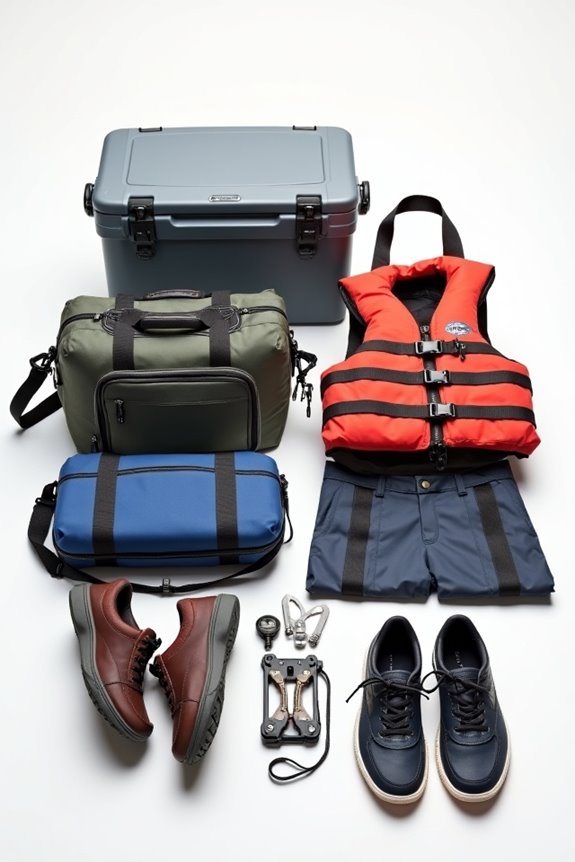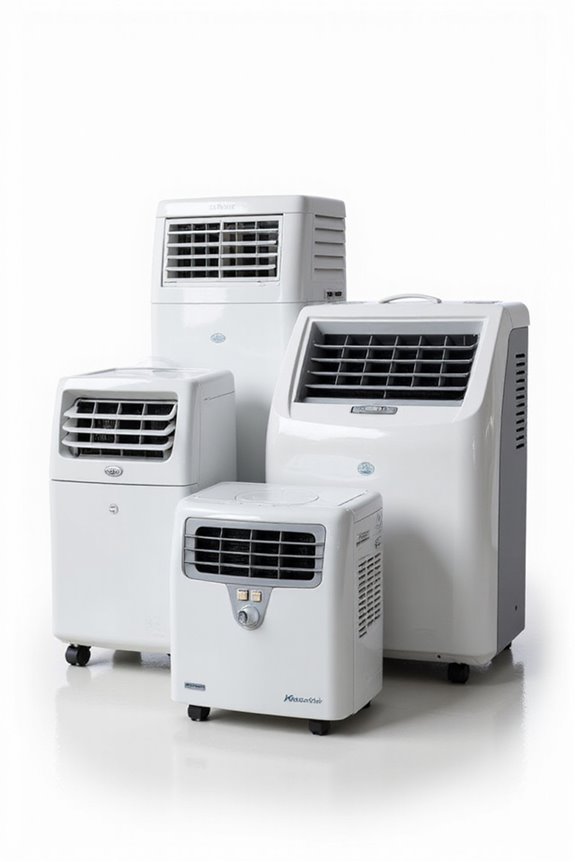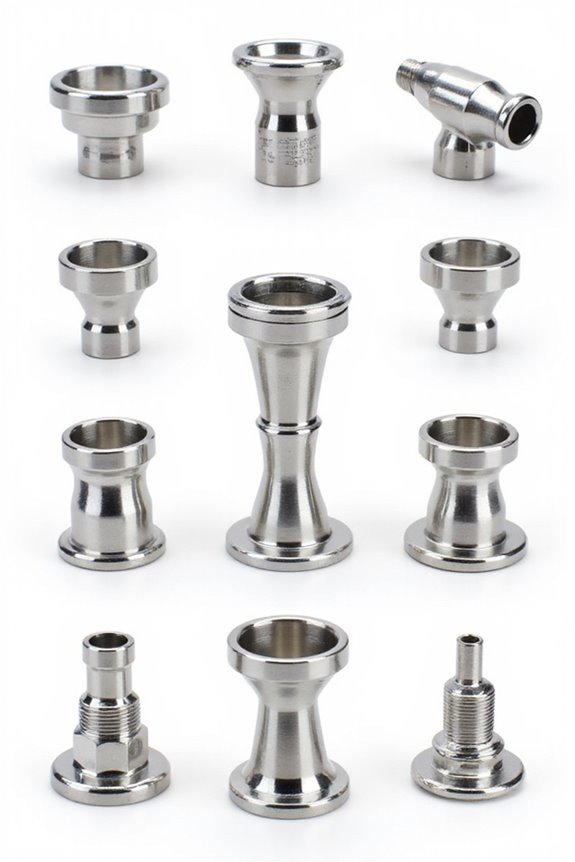As an Amazon Associate, we earn from qualifying purchases. Some links may be affiliate links at no extra cost to you. Although our opinions are based on curated research, we haven't used these products. Articles generated with AI.
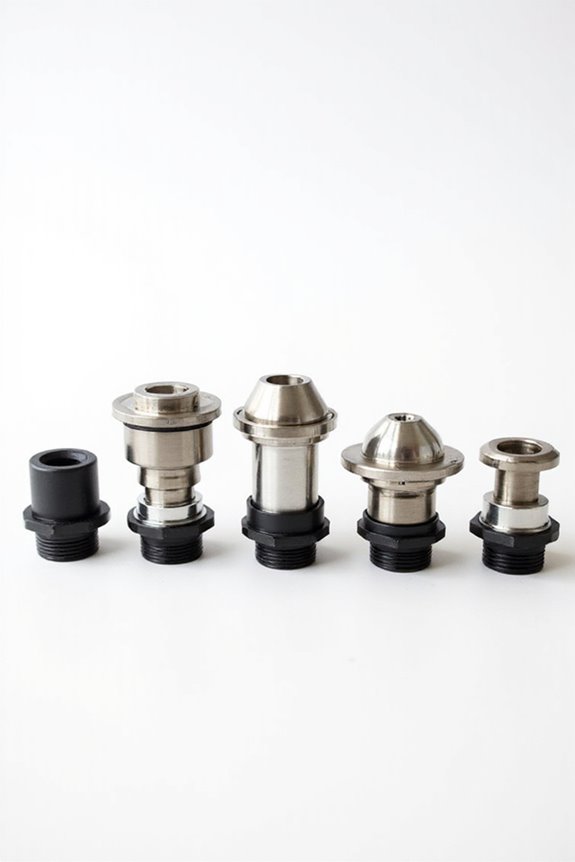
5 Best Boat Gas Tank Vents for Safe and Efficient Fueling
Looking for the best boat gas tank vents? You can’t go wrong with the Seachoice Thru Hull for durable brass, or the Attwood Enhanced 316 Stainless Steel for a sleek upgrade. The Marine Vent Gas Cap prevents tank collapse, while the Keehui and NRC&XRC options offer sturdy stainless steel builds. Make sure to evaluate compatibility and maintenance needs to keep your fuel flowing safely. Stick around, and you’ll find more handy tips to choose the perfect vent!
Key Takeaways
- Choose stainless steel or chrome-plated brass vents for superior corrosion resistance and durability in marine environments.
- Look for vents with multiple holes to enhance airflow and prevent pressure build-up, ensuring smooth fuel flow.
- Ensure compatibility with your boat’s hose size, typically 5/8-inch or 9/16-inch, for optimal performance.
- Opt for vents that require minimal installation modifications to simplify the setup process and save time.
- Regular maintenance, including cleaning and inspections, is essential to ensure long-lasting functionality and prevent fuel spills.
Seachoice Thru Hull Fuel Tank Vent, Chrome-Plated Brass, 5/8 In.
Sale
Seachoice Thru Hull Fuel Tank Vent, Chrome-Plated Brass, 5/8 In.
- Allows for thru-hull fuel tank venting via a hose (not included) from the tank
- Durable, polished chrome-plated cast brass construction for corrosion resistance
- Two vent holes
If you’re a boating enthusiast looking for a reliable way to vent your fuel tank, the Seachoice Thru Hull Fuel Tank Vent is a fantastic choice! Made from durable chrome-plated brass, it resists corrosion while providing efficient fuel flow through its two vent holes. It’ll fit nicely on either a 9/16-inch or 5/8-inch hose, making installation straightforward. With dimensions of 3.75 x 1.75 x 6.75 inches and a lightweight design at just 4 ounces, you won’t even notice it’s there—until it’s time to gear up for your next adventure! Why settle for anything less in your marine accessories?
Best For: Boating enthusiasts seeking a durable and efficient solution for fuel tank venting.
Pros:
- Corrosion-resistant material: Made from chrome-plated brass, ensuring long-lasting durability in marine environments.
- Efficient design: Features two vent holes to facilitate better fuel flow and performance.
- Easy installation: Compatible with both 9/16-inch and 5/8-inch hoses, simplifying setup for boaters.
Cons:
- Hose not included: Requires a separate purchase of the venting hose, which may add to overall costs.
- Limited size options: Only fits specific hose sizes, which may not suit all applications or preferences.
- Requires installation: May not be suitable for those looking for a simple, plug-and-play solution without installation effort.
Attwood Enhanced 316 Stainless Steel Alloy Flush-Mount Fuel Vent
The Attwood Enhanced 316 Stainless Steel Alloy Flush-Mount Fuel Vent is perfect for boating enthusiasts who value durability and aesthetics. Measuring 3 1/4 inches and crafted from robust stainless steel, it’s built to last. Plus, who doesn’t love an upgrade that looks good? Installation is straightforward, although you might need to bore a new hole. Just make sure you’ve got that 4-5 inches of horizontal clearance. While some users have encountered the occasional wrong part, most appreciate its heavy-duty feel and ability to reduce gas fumes effectively. Seriously, a small investment for big performance gains on your boat!
Best For: Boating enthusiasts seeking a durable and aesthetically pleasing fuel vent solution for their vessels.
Pros:
- Durable construction: Made from high-quality stainless steel, offering longevity and resistance to corrosion.
- Effective functionality: Reduces gas fumes effectively when installed correctly, enhancing overall boating experience.
- Easy installation: Generally straightforward process, with only minimal modifications needed for hole sizing.
Cons:
- Potential for incorrect parts: Some users report receiving variations, such as a straight nozzle instead of the expected 90-degree bend.
- Installation requires space: Needs a horizontal clearance of 4-5 inches for proper fitting, which may limit placement options.
- Drilling may be necessary: Existing vent removal and possibly boring a new hole can complicate the installation for some users.
Marine Vent Gas Cap for Moeller Tempo Gas Tank
Marine Vent Gas Cap for Boat Fuel Tank, Marine Manual Fuel Tank Cap for Moeller Tempo Gas Tank...
- 【Wide Compatibility】The boat marine fuel tank gas cap compatible with Moeller Tempo gas tank, also fit for a variety of fuel tank models, including 031103, 031106,...
- 【Manual Venting】The marine fuel tank cap features a twist valve for adjustable ventilation, has a manual venting function, which can prevent fule tank from internal...
- 【Sealing Fuel Tank】The manually vented gas cap creates a tight seal with the fuel tank opening, prevents fuel from leaking out. The marine gas cap also stops air and...
Looking for a reliable gas tank vent for your Moeller Tempo gas tank? The Marine Vent Gas Cap (Part Number: 621501-10) is a game-changer! This durable cap fits various models, creating a tight seal that keeps oxygen and water out. You don’t want a tank that collapses or leaks, do you? With its twist valve for manual venting, you can prevent fuel system corrosion, making your boating adventures worry-free. Plus, it’s made from high-quality, corrosion-resistant plastic, so it’s tough enough for the rough seas. Just remember to give it a quick clean now and then, and you’re all set for smooth sailing!
Best For: Boaters looking for a reliable and durable vent gas cap to prevent fuel leaks and system corrosion in their Moeller Tempo gas tanks.
Pros:
- Durable Construction: Made from high-quality, corrosion-resistant plastic that withstands harsh marine environments.
- Adjustable Venting: Features a twist valve for customizable venting to prevent tank collapse or expansion.
- Tight Seal: Ensures no air or water enters the tank, avoiding fuel mixing and protecting fuel systems.
Cons:
- Maintenance Required: Needs periodic cleaning to prevent dirt or algae buildup.
- Single Pack Availability: Sold as a single unit, may require purchasing multiple for larger setups.
- Manual Operation: Requires manual adjustment for venting, which may be less convenient in some situations.
Keehui Stainless Steel Marine Grade Fuel Gas Tank Vent for 5/8inch Hose
316 Stainless Steel Marine Grade Fuel Gas Tank Vent with Mounting Gasket Hardware Fitting for...
- Material:316 Stainless Steel
- Solid metal slab, very strong, durable.
- Require a approx. 1 3/8-inch hole, it is designed to connect with 5/8-inch Interior Diameter hose.the tank detail sizes refer to the left picture
For boat enthusiasts who value quality and durability, the Keehui Stainless Steel Marine Grade Fuel Gas Tank Vent is a game-changer. Made from tough 316 stainless steel, this vent can handle the rigors of marine life—no wimpy materials here! It fits a 5/8-inch hose and requires an easy 1 3/8-inch hole for installation. What’s more, the fine grinding mirror finish not only looks sharp, but also offers that flatness you want. Since no drilling or welding is required, you can get back on the water in no time. Why settle for less when you can have quality?
Best For: Boat enthusiasts seeking a durable and easy-to-install fuel gas tank vent solution.
Pros:
- High Durability: Constructed from 316 stainless steel, ensuring longevity in marine environments.
- Easy Installation: Requires no drilling or welding, making it simple to set up.
- Aesthetic Finish: Features a fine grinding mirror polishing for an attractive look.
Cons:
- Size Compatibility: Specifically designed for 5/8-inch hoses, limiting its use with other sizes.
- Installation Hole Size: Requires a 1 3/8-inch hole, which may not be standard on all vessels.
- Potential Cost: Stainless steel quality may result in a higher price point compared to plastic alternatives.
NRC&XRC Marine Grade 316 Stainless Steel Fuel Gas Tank Vent Cowl Vent
5/8"O.D.Marine Grade 316 Stainless Steel Fuel Gas Tank Vent Cowl Vent with Mounting Gasket Hardware...
- Made of 316 corrosion-resistant Stainless Steel
- Require a approx. 1 3/8-inch hole, it is designed to connect with 5/8-inch interior diameter hose.the tank detail sizes refer to the left picture
- Adopt fine grinding mirror polishing, precise, bright and with good flatness.
When you’re out on the water, you want equipment you can trust, and the NRC&XRC Marine Grade 316 Stainless Steel Fuel Gas Tank Vent Cowl Vent fits that bill perfectly. This sleek silver vent is crafted from corrosion-resistant 316 stainless steel, ensuring it won’t buckle under saltwater conditions. With easy installation—no drilling or welding required—you’ll find it fits snugly with a 5/8-inch interior diameter hose. Measuring about 3.2 x 1.2 inches, it’s compact yet effective. Customers rave about its reliability, giving it a solid 4.7-star rating. So why not make your fueling process smoother and safer with this fantastic vent?
Best For: Those seeking a reliable and durable fuel gas tank vent for marine boats and yachts.
Pros:
- Corrosion-resistant 316 stainless steel construction ensures longevity in saltwater environments.
- Easy to install design does not require drilling or welding, saving time and effort.
- Compact size (3.2 x 1.2 inches) allows for versatile installation on various vessels.
Cons:
- Limited compatibility as it requires a specific 5/8-inch interior diameter hose.
- Does not include additional installation hardware, potentially requiring separate purchases.
- Higher price point compared to standard plastic alternatives may deter budget-conscious buyers.
Factors to Consider When Choosing a Boat Gas Tank Vent
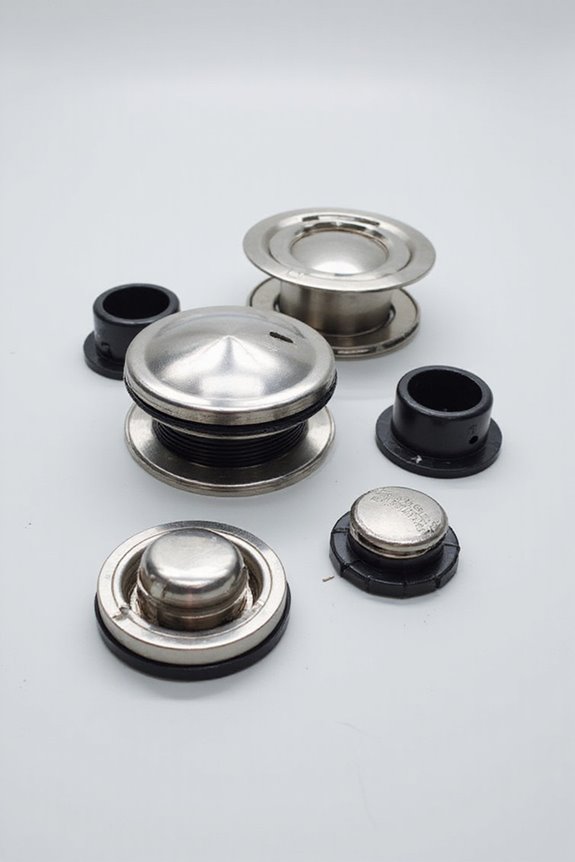
When you’re picking a boat gas tank vent, there are a few key factors you can’t ignore. Think about material durability and resistance—after all, you don’t want to replace it every season! Plus, size, venting efficiency, and even how easy it is to install can make a big difference, so let’s get into the nitty-gritty.
Material Durability and Resistance
Choosing the right material for your boat’s gas tank vent is crucial, especially since it directly influences performance and safety. You’ll typically find vents made of 316 stainless steel or chrome-plated brass, both of which resist corrosion exceptionally well. Why risk leaks and spills when stainless steel offers unmatched strength and longevity? Unlike plastic options, these durable materials stand tough against saltwater exposure and impacts. Plus, many stainless steel products come with fine grinding and mirror polishing, making them look great while boosting their lifespan. Remember, corrosion-resistant materials mean you won’t have to worry about fuel system damage or potential spills. So, when selecting your vent, focus on durability and resistance to keep your boating experience worry-free and smooth sailing!
Size and Compatibility
Finding the right size and ensuring compatibility for your boat’s gas tank vent can feel a bit overwhelming, but it doesn’t have to be! Start by checking the hose size; most vents fit 5/8-inch or 9/16-inch connections, which is essential for proper fuel flow. Don’t forget about the hole size for installation—aim for around 1 3/8 inches in diameter, as many vents require that. Also, make sure the vent matches your boat’s model because some are tailored for specific configurations. If you can install it without extra drilling or welding, that’s a win! Finally, keep an eye on corrosion resistance; in saltwater, this is key to long-lasting performance. Happy vent hunting!
Venting Efficiency
Understanding venting efficiency is crucial if you want to keep your boat’s fuel tank in prime shape. A good vent prevents pressure build-up, which can lead to leaks or even tank damage. Look for vents with multiple holes; they enhance airflow and help your fuel flow smoothly during use. You want a design that minimizes gas fume escape while still allowing for proper ventilation—after all, nobody wants a fuel tank collapse, right? Also, pay attention to the materials. Stainless steel or chrome-plated brass will resist corrosion better in marine environments. Finally, proper sizing matters! Make sure the vent matches your hose diameter to guarantee a snug fit and peak performance. It’s all about keeping things shipshape!
Installation Process
Once you’ve got venting efficiency down, it’s time to think about the installation process for your boat gas tank vent. First, make sure you’ve got the right size and type that matches your fuel tank and hose, usually 5/8-inch or 3/4-inch. You’ll also want to check installation requirements, like a proper hole diameter—typically around 1 3/8 inches—and the horizontal clearance needed for airflow. Don’t forget to follow the manufacturer’s instructions! This might mean removing the old vent and drilling new holes, so grab stepped drill bits to avoid messy damage. Finally, be sure the vent’s securely mounted; nobody wants gas fumes sneaking out or water making guests feel like they’re swimming with sharks!
Aesthetic Appeal
When it comes to choosing the right gas tank vent for your boat, aesthetic appeal is key—it’s all about making sure everything looks good while you’re out on the water. Consider materials like chrome-plated brass or sleek stainless steel; they can really enhance the look of your boat. A well-designed vent that features fine grinding mirror polishing offers not just style but also a bright finish that catches the eye. The vent’s color, whether classic chrome or modern stainless, plays a huge role in visual harmony with your boat’s fixtures. Don’t forget the size and shape! You want a vent that fits perfectly and matches your boat’s theme, whether it’s rugged or refined. After all, style matters, even at sea!
Maintenance Requirements
Maintaining your boat gas tank vents might not sound like the most thrilling part of your boating adventures, but it’s essential for keeping everything running smoothly. Think of it as a pit stop—you wouldn’t skip checking your tires, right? Regularly clean those vents to clear away any dirt, algae, or fuel residue that could block airflow. Don’t forget to inspect for wear or corrosion, too. That twist valve on adjustable caps? It better seal tight, or you risk corrosion and air leaks. Check those hoses for cracks or blockages during routine maintenance. Staying on top of this keeps fuel flowing and helps prevent problems like tank collapse. After all, smooth sailing relies on well-maintained vents!
Functionality Features
Choosing the right functionality features for your boat gas tank vent can make all the difference in your on-water experience. First off, look for multiple vent holes; they help guarantee efficient fuel flow and cut down on pesky vapor lock. You’ll also appreciate durable materials like stainless steel or chrome-plated brass since they resist corrosion in salty environments. Double-check compatibility with standard hose sizes—either 5/8-inch or 9/16-inch. Easy installation is key, so vents that don’t require drilling? Yes, please! Plus, adjustable venting features, like twist valves, are great for preventing fuel tank issues induced by pressure changes. After all, your boat should float, not flop! So, choose wisely, and enjoy a smooth ride!
Cost and Value
Cost matters, especially when it comes to your boat gas tank vent. You’ll notice that prices can vary wildly, with stainless steel models costing more but offering superior durability. It’s tempting to go for the cheap plastic options, but wouldn’t you rather invest in materials that resist corrosion and last longer? Don’t forget to factor in installation costs; some vents are more complex than they look and may need a pro’s touch. A warranty or return policy can also ease your mind about spending. Finally, check out customer reviews—are others satisfied? Knowing what works can help you get the best bang for your buck. After all, you don’t want your vent to spring a leak during your next adventure!
Frequently Asked Questions
How Do I Know the Right Size Vent for My Gas Tank?
Choosing the right size vent for your gas tank isn’t rocket science, but it can feel a bit puzzling. Start with your tank’s capacity and dimensions, then check the manufacturer’s recommendations—trusted sources can really save you headaches! You want enough airflow without overdoing it, right? Don’t forget to take into account potential environmental factors, like waves splashing. It’s a balancing act, but with a bit of research, you’ll find the perfect fit!
Can I Install a Gas Tank Vent Myself?
Absolutely, you can install a gas tank vent yourself! It’s not rocket science—more like DIY fun, minus the woodshop class. Just make sure you’ve got the right tools and a proper understanding of the system. First, identify the vent size you need, then secure it firmly to prevent leaks. Follow the manufacturer’s guidelines, and soon you’ll be enjoying your boating adventures with peace of mind. Just don’t forget the sunscreen!
What Materials Are Best for Marine Gas Tank Vents?
Did you know that nearly 30% of boating accidents are related to fuel issues? When it comes to marine gas tank vents, using quality materials is key. Look for UV-resistant plastics or stainless steel options; they resist corrosion and stand up to harsh conditions. Rubber gaskets are essential for sealing. It’s like giving your boat an insurance policy against leaks. Remember, a reliable vent means smoother sailing and less worry!
How Often Should I Inspect My Fuel Tank Vent?
You should inspect your fuel tank vent regularly, ideally during routine maintenance, about once a month. Check for clogs, rust, or any signs of wear. If you notice any issues, fix ’em ASAP—nobody wants a fuel leak ruining your day on the water! And hey, while you’re at it, take a look at your other fuel system components. A little love can keep your boat running smoothly and safely for seasons to come!
Are There Any Regulations for Gas Tank Vents in Boating?
You bet there are regulations for gas tank vents in boating! The Coast Guard and ABYC set strict guidelines to guarantee safety. Your vent has to let air in but prevent fuel vapors from escaping, kinda like a bouncer at a club—but for your gas tank. Keep it properly maintained and make certain it’s located away from ignition sources. After all, you don’t want any unexpected party crashers, right? Stay safe out there!






